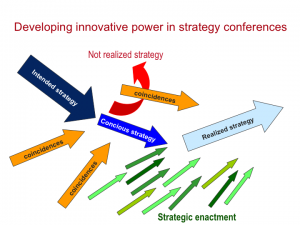Strategy Conferences

Strategy conferences can be a tool in this process of strategic development. In strategy conferences, a variety of people come together for several days to find a common ground and to develop a perspective for the future. From this shared vision the participants explore how this future might become reality.
The design and supervision of strategy conferences is a challenge I like to take up.
Many organizations have lost sight of their meaning and people have lost their enthusiasm. Strategy conferences help bring strategy and execution back together again and return meaning to organizations.
Background and experience
The idea of strategy conferences is not new. The essence of this method is that people search together for developments in the surroundings and the strengths and weaknesses of their own organization. The ambitions of all parties involved are listed, and there is an examination of how developments in the surroundings can be brought together with ambitions. Then a course is laid out to realize the situation desired in the future from the position of the existing organization.
In the eighties and nineties several methods were developed for strategy conferences. One much-used method is the ‘Future Search’ developed by Fred and Merrelyn Emery. You can find a concise description of this method in the chapter by Merrelyn Emery about the implications of the open system theory for the development and learning of organizations in my handbook “Dynamics of Organizational Change and Learning”. You can download this chapter here: Future search and search conferences.
Other methods for strategic conferences are the ‘Search Conference’ developed by Marvin Weisbord and ‘Real Time Strategic Change’ by Robert Jacobs. Weisbord’s Search Conference assumes that all parties involved cooperate in analyzing the past, describing the present and imagining the future. The method is elaborated in his book ‘Discovering Common Ground’ and elsewhere. Jacobs’ method is similar.
Personally I am taken by the scenario method whereby you list existing developments with the parties involved and investigate possibilities for the future. Kees van der Heijden has described the method most wonderfully in his book ‘The art of strategic conversation’.
Setting up strategy conferences
When I am setting up strategy conferences I work together with the people involved to come to an optimum method of working. Every situation is different and there are no ready-made designs for conferences. The strategic conversation already starts when you are thinking about the best way to give shape to the conference. Important questions are:
– who are involved as problem owner, actor and relative outsider?
– what is the essence of the issue and the underlying dynamics?
– which different points of view are essential?
– what kind of structure is possible and what part do the present, the past and the future play?
– how do we play with time, place, space and rhythm?
– how is learning given shape and how does conflict play a part?
Example of a strategy conference
One example of a way to work with strategy conferences is the strategy development of neighborhood councils in the city of Amsterdam. These councils were struggling several years with the question of their right to exist. They wondered what their social meaning could be in relation to the town administration and the neighborhood they worked in.
In their quest for new future possibilities, the neighborhood councils started by researching their own history and activities and contributions. What emerged was that quality of life, safety, housing, transport, environmental pollution and multicultural cooperation were the major areas of activity. This self-examination brought clarity to the historical meaning of the councils; they concluded that they brought people in the neighborhood together on valuable themes, that they played an important part in making problems in the neighborhood clear to the local politicians, and that they made a contribution to finding solutions for problems in the neighborhood.
Most people of the councils had a close relationship with the neighbourhood residents and knew what was important in the neighborhood. The council members were able to get people together to understand problems and translate them into realistic initiatives and plans of action. During the research process and appreciative investigation the members of the neighborhood councils rediscovered their identity and pride. A vision of the future was formulated communally: on the basis of a direct democracy, contribute to quality of life and safety in neighborhoods. These plans were discussed and experiences exchanged in a series of meetings.
The members of the neighborhood councils learned how important it was to base their policy plan on discussions in the neighborhood and contact with the residents. They also learned that making their own position and policy explicit and making their activities visible could contribute to them becoming a discussion partner again in the town district administrations. Almost all councils unfolded new initiatives to improve the quality of life and safety in the neighborhood together with volunteers, local residents, town district councilors and people from professional organizations. This article about this strategy development conferences may be downloaded here: Multiple Voices of Democracy in a Cosmopolis
